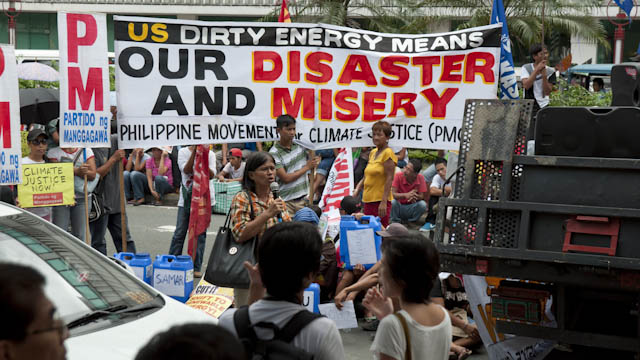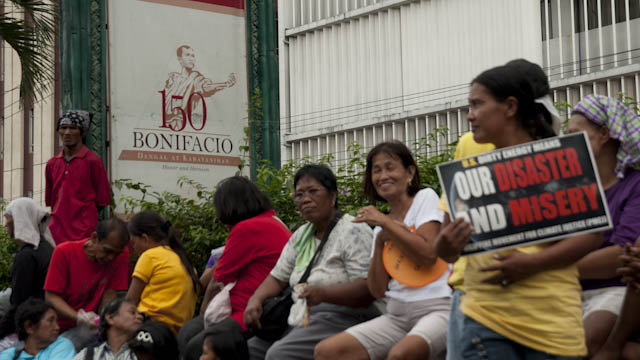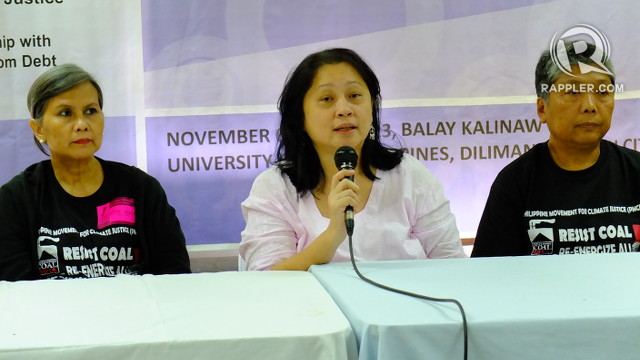SUMMARY
This is AI generated summarization, which may have errors. For context, always refer to the full article.

MANILA, Philippines – Developed countries responsible for global warming must pay for losses and damages experienced by developing countries due to disasters related to climate change.
This was the demand made by Filipino environmentalists during a rally in Manila on Monday, November 11, that coincided with the opening of the United Nations climate talks in Warsaw, Poland. (READ: Stop this climate crisis madness)
The rally was held only two days after Super Typhoon Yolanda (international codename Haiyan) exited the Philippines, leaving more than 1,800 dead and affected millions in 41 provinces, according to a November 13 situation report by the National Disaster Risk Reduction and Management Council.
“The message is simple: the developed countries should owe to their responsibity of over-emissions of greenhouse gases, which result in bigger, more disastrous storms,” declared Gerry Arances, national coordinator of green group Philippine Movement for Climate Justice (PMCJ).
“We bear the brunt. Yolanda is a wake up call not only for Filipinos, but for these countries as well.”
The demand for accountability was echoed by no less than Philippine President Benigno Aquino III during a CNN interview: “Especially to the most developed countries that are contributing immensely to global warming, there has to be a sense of moral responsibility that what they wreak is playing havoc on the lives of so many others incapable of defending themselves.”
$100 billion ‘not enough’
The US and other developed countries owe countries like the Philippines “a huge climate debt,” according to environmentalist Lidy Nacpil, who has flown to Poland for the UN climate talks.
Climate debt is based on the idea of “natural commons” which states that the Earth’s atmosphere is collectively owned by all humans. This means its benefits must be shared equally among everyone and responsibility to protect it is also collective.
Because developed countries, through their excessive carbon emissions, have reduced the capacity of the atmosphere to absorb greenhouse gases and curb global warming, they must pay damages to developing countries who suffer from the effects of the phenomenon.
The debt paid can then be used to help developing countries improve their resiliency aginst climate change.
Advocate groups, like the Global Campaign To Demand Climate Justice, peg the climate debt at $500,000, said Arances, whose group belongs to the coalition.
“They’re pledging $100 billion right now for the Green Climate Fund. But it’s not enough for all the developing countries,” he said.
The Green Climate Fund, under the UN climate change convention, is reserved for helping developing countries deal with climate change.
So far, only P2.4 billion is in the fund – “a far cry from the P604-billion economic impact it has cost the Philippines, which is equivalent to 5% of the country’s gross domestic product,” said Albay Governor Joey Sarte Salceda, who also chairs the Fund’s board.
The fund will be operationalized in 2014. It promises to “provide simplified and improved access to funding, including direct access, basing its activities on a country-driven approach, and will encourage the involvement of relevant stakeholders, including vulnerable groups.”
Responsibilities of industrialized countries
Global warming can drastically change the planet’s climate system. When the climate system’s balance is tipped, freak storms, heat waves, floods, droughts and other extreme weather conditions brew. Extreme weather conditions are more and more becoming the “new normal.” (READ: After Yolanda/Haiyan: The worst is yet to come)
Who is to blame for the carbon dioxide emissions? While all countries still derive part of their energy from fossil fuels, the share is by no means equal.

Historically, it’s the industrialized, developed countries like the United States and European Union states which continue to burn up the biggest amount of fossil fuels.
Despite making up only 20% of the world’s population, developed countries have produced more than 70% of historical emissions since 1850.
The US is among the biggest culprits.
“Around 44% of the power supply of the US is from coal. They have the biggest coal industry with 1,400 coal-fired power plants. Imagine the burning they do,” said Arances who initially planned to hold the rally in front of the US Embassy in Manila. Policemen blocked their path because they lacked a rally permit.
In the UN Framework Convention on Climate Change, Annex I countries – those that have large amount of carbon emissions – are legally-bound by UN climate agreements to cut down their carbon emissions to their 1990 levels. The goal is to keep global temperatures at 2ºC (3.6ºF). According to AR 5, temperatures higher than this is “catastrophic.”
The UN convention also binds Annex I countries to provide financial support for “climate change activities” of developing countries “above and beyond any financial assistance they already provide to these countries.”
More renewable energy
Current concentration of greenhouse gases has reached 398 parts per million (ppm). To keep global mean temperature safely below 1.5ºC, this figure must be brought down to 350 ppm, said Nacpil.
The Philippines, battered by around 20 storms a year, is even more vulnerable to increasing temperatures because whatever the global mean is, it is hotter in tropical countries.
One strategy deemed effective by environmentalists is shifting to renewable energy, or energy derived from continually replenishable sources like solar power, wind, geothermal heat, tides and waves. This source of energy produces significantly less greenhouse gases.
Only around 16% of the world’s energy mix comes from renewable energy. But climate change advocates hope this figure rises as renewable energy becomes more and more affordable.
But many vested interests are at stake. Many developed countries and emerging economic powers like China believe their economic development will only be hampered by abandoning fossil fuels, which is a cheaper source of energy.
In the Philippines, the Department of Energy’s outlook is still very much coal-oriented despite the Renewable Energy Act which calls the government to pursue renewable energy and reduce dependence on fossil fuels. (READ: Green groups to DOE: What happened to renewable energy?) – Rappler.com
Add a comment
How does this make you feel?

There are no comments yet. Add your comment to start the conversation.